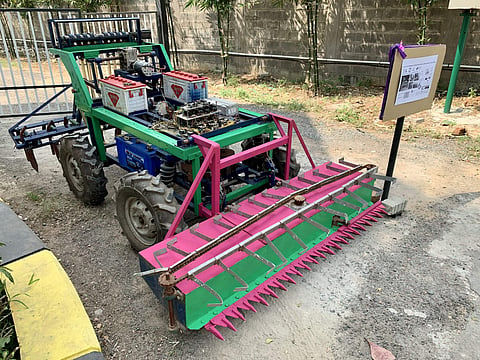

Adithya Mohanavel, an engineering student at B S abdur Rahman Crescent Institute of Science and Technology, comes from a family of farmers. Every time he visits his ancestral home near Kancheepuram, he is saddened by the plight of the farmers — most of whom are elderly and have no option but to toil in the fields throughout the day because their children have moved to cities in search of education and better jobs.
Adithya, who is currently pursuing his B TEch CSE, specialising in AI and IoT saw a two-fold problem here. One, the health and well-being of old farmers was being affected greatly. Two, as more and more youngsters moved to cities, there were fewer people taking up farming and left Adithya worried that farming would cease in a few decades.
That's when he decided to put his engineering and robotics education and skills to use. He established a start-up called Tradent to develop an automated electric tractor or an agricultural robot. This tractor can move around farmland and perform tasks like sowing, ploughing, seeding and harvesting. It can all be done just by giving a command through a phone or computer or other digital devices. Basically, the tractor can be used as an alternative to a conventional tractor. The main stages of farming such as cultivation, ploughing and seeding can be done with the tractor without any physical input. But maintaining fields with pesticides, checking the health of the crops and harvesting might require minimum and occassional manpower.
Tradent is currently in the Research and Development stage and has developed one concept vehicle and one vehicle for testing on-field to collect data and improve efficiency. The tests were done in fields near Kondrattur and Vandalur. The team measured two key parameters -- one, whether it is a good alternative to conventional tractors, and two, whether it was user-friendly. Adhitya explains, "There are farmers who are still not able to adapt to technology. So we're looking at ways to make it easy for everyone to use."
He adds, "I'm targetting two groups - elderly farmers and the younger generation. When the elderly farmers sit in the tractors, it causes a lot of vibration which will affect their backs and is bad for their health. This problem can be avoided using our automated tractor. Also, many youngsters who are from a farming family have moved on to cities and don't want to go back to their villages or take up farming. They might still own land, but they won't be able to cultivate it. In such cases, our tractor can help them operate it and do farming from the cities they live in."
To navigate without hitting objects, the tractor uses LiDAR - a light-based radar that can scan what is present around the tractor and react accordingly. For instance, when it commanded to plough, and a cow comes in between, it will sense the obstacle and change course. Adithya hopes that his tractor will increase the quality of life of farmers and encourage more youngsters to take up farming.
